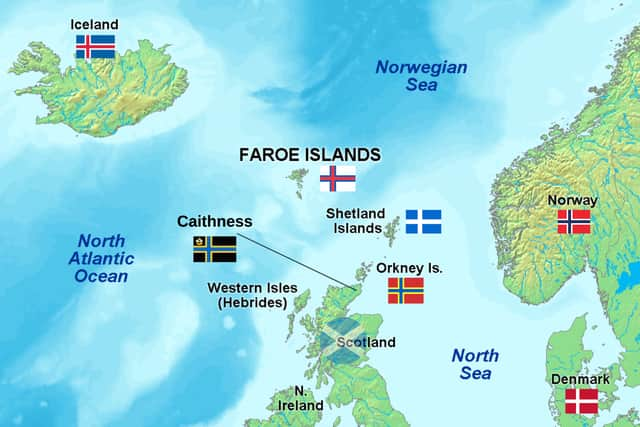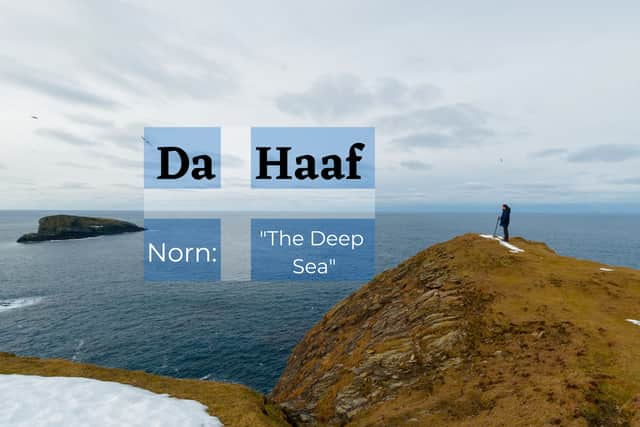The Norn Language: Scotland’s ancient Viking tongue that is found in modern Scots


Broadly speaking, Etymologists divide Scandinavian languages into two historical branches; Western and Eastern. Danish and Swedish account for the Eastern examples while the Western includes Norwegian, Icelandic and Faroese.
Just as Iceland and the Faroe Islands were largely settled by Norwegian Vikings, regions of Scotland like the Shetland Islands also underwent this Norse invasion which led to the birth of another Western Scandinavian language; Norn.
Advertisement
Hide AdAdvertisement
Hide AdThe New European tells us that it “was spoken in Shetland for more than 1,000 years” and also in places like “Orkney and on the northeast Scottish mainland in Caithness.” As with other extinct languages of the British Isles like Brythonic (thought to be spoken by the Picts) there is a scarcity of historical documents on Norn meaning it is shrouded in mystery.
That said, here’s what we do know about this “sixth Scandinavian language”, how it came to rise and fall in Scotland, where it is still found today and if there is any hope for its revival.
What is the Norn language?
Originally known as Norrœna, Norn is an extinct North Germanic language that was a variant of Old Norse. It was mostly spoken in the Northern Isles of Scotland in Orkney and the Shetland islands but was also found in the Scottish mainland in Caithness.
Vikings who came from West Norway first started building settlements on Scotland’s archipelagos around 850 AD and this is seen as the startpoint of the Norn language evolving from Old Norse. Scottish place names with Old Norse motifs can be found scattered throughout the entire country but the “amount of place names with a Norn element” in regions like Shetland reflect how such regions were heavily colonised by Norsemen.
For example, the Shetland Government reports that the village of Walls in Shetland comes from the Norn adjective “Waas” (Vaas’) which describes “the way the sea comes into the bay”.


Who are the closest living relatives of Norn?
The Shetland Organisation reports that Norsemen “arrived in Shetland from western Norway about 850 AD and subsequently settled in the islands, giving rise to what is known as the Norse Period.” At this time they brought their version of Old Norse to the isles, and subsequently colonised other territories like the Faroe Islands and Iceland which inherited their own offshoots of the language.
For this reason, the closest living Scandinavian relatives of Norn are Icelandic and Faroese. Norn is also associated with Scots Leid (the Scottish language often associated with Robert Burns) by way of its presence in dialects like Shetlandic. This example of Scots Leid is considered one of the most ‘distinctive’ variants of Scots as it reflects Shetland’s unique history.
In the Shetland dialect you may hear “da haaf” which refers to “the deep sea”. This is written as “haf” in Old Norse. A better-known Scots word “bairn” - which refers to a child - is said to originate from the Old Norse “barn” which means the same thing.


Examples of the Norn language
Advertisement
Hide AdAdvertisement
Hide AdWe have little knowledge of the structure of Norn given the scarcity of historical documents surrounding it. Although official texts have been preserved from the time of its existence, it was seen as the language of ‘common people’ and so was never used in writing unlike Norwegian or Danish.
However, Orcadians (people of Orkney) who spoke their own variant of Norn for almost 1,000 years do boast one of the most ancient artefacts in the language which is the Lord’s Prayer:
Matthew 6:9-13, Orkney Norn (Wallace transcription; 1700)
Favor i ir i chimrie, Helleur ir i nam thite,
gilla cosdum thite cumma, veya thine mota vara gort
o yurn sinna gort i chimrie,
ga vus da on da dalight brow vora
Firgive vus sinna vora sin vee Firgive sindara mutha vus,
lyv vus ye i tumtation, min delivera vus fro olt ilt, Amen.
English Translation
Our Father, who art in Heaven, hallowed be Thy Name.
Thy Kingdom come, Thy Will be done,
on Earth, as it is in Heaven.
Give us this day our daily bread, and forgive us our trespasses,
as we forgive those who trespass against us.
And lead us not into temptation, but deliver us from evil. Amen.
How did Norn become extinct?
Shetland and Orkney, the heartlands of Norn, were part of the Danish-Norwegian kingdom. However, this changed in 1469 when the Danish king pawned them off to the Scottish crown due to a marriage settlement. The Open University reports that this led to Scots gradually moving into the islands and bringing their legal system, religion, influential figures and language with them.
This transition to Scottish culture happened even faster in Orkney due to its proximity to the mainland. Given that Scots Leid was the ‘lingua franca’ of Scotland at this time it started to replace the northern isles’ Scandinavian tongue.
Norn is thought to have officially become extinct in 1850 after the death of the language’s last-known native speaker; Walter Sutherland.
Could Norn be revived in Scotland?
Norn is still said to live on as a ‘ceremonial language’ in the Northern Isles as it is used to name marine vessels like ferries. Its influence can also be felt in the locally spoken Scots language but its use as its own language is long over.
Advertisement
Hide AdAdvertisement
Hide AdHowever, other languages (most famously Hebrew) have been ‘brought back from the dead’ following revitalisation campaigns and such an effort was applied to Norn in 2006 with the Nynorn Project. Literally meaning “New Norn” this reconstruction of the Norse language entered the digital space in 2006 and sought to bring the sound of Norn back to everyday conversations.
While it is unlikely that the language will be revived, especially as Scotland is already occupied with preserving the endangered Scottish Gaelic, the team still successfully created resources that can connect enthusiasts to Norn. To explore their wealth of insightful materials you can visit the Nynorn website to learn more about this regrettably extinct yet fascinating heritage.
Comments
Want to join the conversation? Please or to comment on this article.
